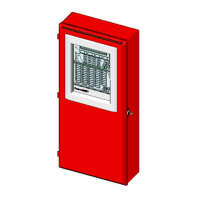Installation
P/N 06-237058-001 2-27 February 2012
2-8 SETTING UP WIRING TO FIELD DEVICES
Requirements for field wiring connections to the control unit are determined by national and local
codes. Refer to NFPA 72, “National Fire Alarm and Signaling Code” for more detailed information.
2-8.1 Installing Electrical Wiring and Making Connections
Route the properly-sized and required wiring through conduit from the control unit to the field
devices. Observe the wiring manufacturer’s recommended minimum bending radii for all internal-
control-unit and external wiring. Use appropriate equipment to check and record the wiring for
insulation resistance to earth ground. Measure and record the wiring resistance for all external
circuits. Also measure and the record the SLC wiring capacitance. Refer to the approved electrical
installation drawings and to the recommendations in this manual.
Mount and make wiring connections to the peripheral devices as shown in their installation
instructions. Be sure that all SLC-based devices have been electronically addressed prior to
installation.
2-8.2 Overview of SLC Wiring Styles
The basic difference between wiring styles is the ability of the circuit to continue operating under
conditions that compromise the integrity of the circuit itself.
• CLASS-A is a 4-wire circuit where two wires of the circuit leave the control panel, make
connection with the field devices, and then return to the same control panel. In this type of
installation, if one wire were to break or become loose, a Trouble signal would occur; however,
all devices on that circuit would continue to function. CLASS-A circuits will be able to transmit
a signal even with a single open fault or a single ground fault on the circuit.
• CLASS-B is a 2-wire circuit where two wires leave the control panel, make connection to the field
devices and then connect to an "End-of-Line" device. If a wire were to break or become loose, a
Trouble signal would occur but, unlike CLASS-A wiring, all devices downstream of the break
point would not function. CLASS-B circuits will not be able to transmit a signal beyond a single
open fault..
• CLASS-A, Style 7 is a 4-wire circuit which is operational past a single open fault, ground fault or
short circuit and requires the use of loop isolators.
2-8.3 Electrical Supervision
• A short circuit from any field-wiring terminal (except AC-Power-Input Terminals and Form-C
Relay Terminals) to earth ground will create a “Ground-Fault” trouble condition.
• An open circuit in the wiring for the SLC circuits, the outputs (NACs and R-NAC circuits), the
RS-485 communications circuit, and the battery-charging circuit will create an “Open” trouble
condition.
• A short circuit between conductors in the wiring for the SLC, the outputs (NACs and R-NAC
circuits), the RS-485 communications circuit, and the battery-charging circuit will create a
“Short” trouble condition.
Exception: R-NAC circuits wired as non-power-limited.
• Impedance values for open-circuit and short-circuit conditions are:
– open circuit: infinite ohms
– short circuit: zero (0) ohms

